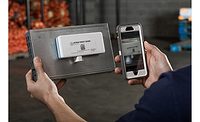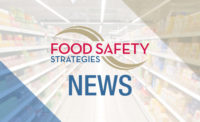Foodservice pandemic safety: An update on an industry in flux

As the pandemic continues, foodservice operators have had to adapt in order for their businesses to survive, and maybe even thrive.
Change of plans
“The pandemic caused a need for increased food safety along every aspect of the supply chain. In response, we’ve seen more companies invest in advanced food safety solutions to enhance traceability, visibility and compliance,” says Bernard Clement, PENN refrigeration product management at Johnson Controls, Milwaukee, WI.
“To meet this growing demand, we launched PENN Connected Digital Food Safety, a cloud-based digital compliance management solution for food retailers, service providers and manufacturers,” he says.
“The most important lesson from the pandemic is the need to be adaptable. As it relates to food safety, it became important to be able to train employees, reprioritize deployment to immediate tasks, and reorganize the business without losing traceability or efficiency. Food safety is a top priority, and a digital food safety solution is one of the most effective ways for companies to automate data monitoring, recording and reporting without extra hassle or stress,” Clement finishes.
Jane Foreman, senior manager of sales and planning, Kikkoman Sales USA, Inc., San Francisco, says that the demand from [their] customers is rapidly changing in drastic ways.
“We are working hard to meet their evolving needs and find solutions to make the transition to the ‘new normal’ as seamless as possible. The Kikkoman Sales USA, Inc. culinary team is working with chefs and restaurant chains to find solutions that require less kitchen prep, to save on labor costs and reduce touch points,” she says.
“One of the most immediate changes that we saw was the removal of on-table condiments and the pivot to portioned ramekins or sauce packets for guests. While definitely a transition, delivering ramekins of sauce to customers allows for better portion control, less waste and fewer contact points for guests,” she notes.
It also provides the opportunity for specially blended sauces to satisfy a variety of palettes. For example, adding Kikkoman Soy Sauce or Thai-Style Chili Sauce to a mayonnaise creates an elevated aioli for guests to drizzle over their entrees and appetizers after pick-up, Foreman adds.
“Guests are also getting creative with the term ‘going out to eat,’ which may mean they are picking up takeout and enjoying a socially distant dining experience with friends in a park. Sauces are part of the to-go toolkit and it’s important to have the perfect flavors to help customers have a memorable dining experience, no matter where they are enjoying their dishes,” she finishes.
Kristin Azzarello, RD, LDN, district manager, Cura, a member of the Elior North America family of companies, Canonsburg, PA, says that they have made many changes to their foodservice plan.
Cura is a senior living, behavioral health, and acute care dining services provider, and it specializes in serving senior living communities, community hospitals, and healthcare systems. They currently service culinary management programs across the United States through the efforts of hundreds of highly dedicated managers, dietitians and culinary professionals.
“A COVID-19 video training series was developed to educate all staff and was included in our monthly SAFE Training series for all staff members. [In addition], Elior developed a COVID-19 playbook. Each Elior segment developed their own specific COVID-19 playbook based on their specific needs,” she says.
Seating arrangements in the dining areas changed in conjunction with the social distancing guidelines, and they removed tables and chairs to limit the number of guests who could sit in the dining areas, Azzarello adds.
Other steps they have taken include:
- Plexiglass barriers at cash register stations
- Salad bar no longer self-service
- Eliminated all self-service stations
- Grab n Go selections increased
- Heat at Home program expanded
- More training and education on PPE usage
- Grocery store items offered in the cafeteria (mini grocery stores)
- Dining rooms closed in senior living and trays were delivered to their rooms.
- Dining Assistants called patients for their meal orders instead of visiting their rooms to decrease the number of people in contact with the patients.
- SAFE café guidelines introduced
- Condiments no longer offered in bulk; all individually packaged
Some fallout from these steps included:
- Gift Shops closed and lost revenue
- Cafeteria limited to only staff members with visitor restricted caused a reduction in revenue
- Catered events were cancelled and revenue lost
Cleaning and sanitation procedures
Azzarello says that Elior has always followed cleaning and sanitation protocol to meet regulatory guidelines and to prevent cross contamination and foodborne illnesses.
“[We] partnered with Ecolab (chemical company) for detailed COVID-19 playbook information. Ecolab approved cleaning processes by location. [We also have a] strategy for more frequent cleaning, and made sure we were using chemicals that met the CDC guidelines.
Other procedures that they follow include enhanced cleaning and sanitation, increased cleaning of high-touch surfaces, and adding more sanitation stations that are located throughout the cafeteria and dining room areas. They also developed a Safe Café Checklist.
For carryout and delivery items, Azzarello says that staff members should all wear proper PPE and be trained on usage.
“[These include] washing and sanitizing their hands in and out of their vehicles, and cleaning and sanitizing the high touch points of their vehicles. [We also have a] Heat at Home Program, with meals for the family, and reheating instructions on food. We also alert consumers about the temperature danger zones and how long food can be out of the temperature danger zone before the food should not be consumed.”
Elior also alerts consumers to what food should be refrigerated or kept frozen; keeps food temperature logs; and has proper hot and cold holding equipment to transport food and keep at the appropriate temperature out of the temperature danger zone.
Clement says that cleaning and sanitation practices across the industry are now forever changed.
“For example, retailers have developed countless of cleaning plans—from the cart at the entrance to the oven door handle. Digital food safety solutions, like PENN Connected, provide enterprise-wide deployment, including access and visibility to important compliance processes such as cleaning and sanitation. With features like automated checklists, facility managers and executives alike can ensure employees are washing their hands, keeping equipment clean and handling products with the upmost care. And by having the right digitized food safety system in place, sanitization and monitoring can be achieved within one, all-purpose system.”
Ghost kitchens
“Ghost kitchens”—aka renting kitchen space from restaurants or other businesses—is an option for businesses, but these are caveats with this as well. A ghost kitchen isn’t always a restaurant brand, and may contain kitchen space and facilities for more than one restaurant. They also have no dining area for walk-in customers. Ghost kitchens also require Department of Health approval prior to use.
Although Azzarello says that Elior is a contract company and does not lease out space, there could potentially be liability issues with ghost kitchens.
“If the location wasn’t being used due to a closure of their business and someone else needed the space—for example, a COVID-19 outbreak in their kitchen—that would be a way to generate revenue instead of losing money due to a shut down,” she adds.
However, companies would need to ensure the ghost kitchen is properly cleaned and sanitized before being used, Azzarello suggests.
“[The company] would need to conduct a safety walk through assessment of the location, [including] ensuring it’s up to code and meeting OSHA standards,” she says.
Supply-chain challenges
Azzarello says that protein shortages have led to menu changes, and that they made sure the patients were the priority and changed retail menus as needed.
“Low inventory of some products caused many substitutions. If patient menu items were affected, a dietitian needed to approve the substituted produce to ensure nutritional equal to what was being replaced,” she adds.
They also didn’t [initially] budget for masks and gloves, as supply and demand meant an increase in prices.
“There were also hand sanitizer shortages, and we needed to ensure washing hands with soap and water if hand sanitizer wasn’t available. In addition, some vendors would not deliver to the kitchen, so we had to send a staff member to the loading dock for the order,” she finishes.
Clement says that their partners throughout the industry—in particular, food retail, service and hospitality—have experienced unprecedented supply chain disruptions due to the pandemic.
“These include extreme fluctuations in product supply and demand, transportation challenges, evolving service models, product and process training, labor shortages and, of course, a heightened focus on cleaning and sanitation at every link in the chain. Partners who were equipped with digital systems had the peace of mind that their data was handled properly,” he expands.
These challenges have fast tracked the need for accurate, reliable and real-time data monitoring, recording and traceability, Clement adds.
“As reinforced by the FDA’s New Era of Smarter Food Safety, technology and other tools are needed to create a safer and more digital, traceable food system. As a result, we’ve seen increased interest and investment in modern food safety solutions that replace traditional clipboards and pen and paper with digital tools to help organizations adapt to today’s unique food safety standards.”
Related: Slideshow - Foodservice pandemic safety: An update on an industry in flux
Looking for a reprint of this article?
From high-res PDFs to custom plaques, order your copy today!






